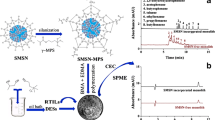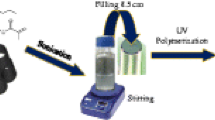Abstract
A new chromatographic stationary phase was prepared by making a soft organic monolith based on thermal polymerization of methyl methacrylate and ethylene glycol di-methacrylate with an aid of gas evolution via decomposition of urea, and by crushing the monolith into particles. The original purpose of urea incorporation was formation of monolith particles with affluent mesopores, but the actual effect was reduction of the particle size to a proper range (mostly in the range of 1–5 μm with an average of ca. 3 μm), which was very crucial for improvement of separation efficiency. A series of washing processes (including common washing and reflux washing) were carried out to remove un-reacted materials and free oligomers. The columns were made by packing the organic monolith particles in glass-lined stainless-steel tubing and evaluated for their performance with the mixture of six aromatic compounds (3-phenyl-1-propanol, acetophenone, methyl benzoate, 2-nitroaniline, ethylbenzene, cumene). The overall number of theoretical plates (N) over 6 analytes based on 6 columns was 32,000 plates/column (107,000 plates/m, 9.4 µm plate height).






Similar content being viewed by others
References
Arrua RD, Talebi M, Causon TJ, Hilder EF (2012) Review of recent advances in the preparation of organic polymer monoliths for liquid chromatography of large molecules. Anal Chim Acta 738:1–12
Ding X, Yang J, Dong Y (2018) Advancements in the preparation of high-performance liquid chromatographic organic polymer monoliths for the separation of small-molecule drugs. J Pharm Anal 8:75–85
Gamma MR, Rocha FRP, Bottoli CBG (2019) Monoliths: synthetic routes, functionalization and innovative analytical applications. Trends Anal Chem 115:39–51
Josic D, Buchacher A, Jungbaer A (2001) Monoliths as stationary phases for separation of proteins and polynucleotides and enzymatic conversion. J Chromatogr B 752:191–205
Lynch KB, Ren J, Beckner MA, He C, Liu S (2019) Monolith columns for liquid chromatographic separations of intact proteins: a review of recent advances and applications. Anal Chim Acta 1046:48–68
Podgornik A, Yamamoto S, Peterka M, Krajnc NL (2013) Fast separation of large biomolecules using short monolithic columns. J Chromatogr B 927:80–89
Vlakh EG, Tennikova TB (2009) Applications of polymethacrylate-based monoliths in high-performance liquid chromatography. J Chromatogr A 1216:2637–2650
Walsh Z, Paull B, Macka M (2012) Inorganic monoliths in separation science: a review. Anal Chim Acta 31:28–47
Wu Q, Sun Y, Gao J, Dong S, Luo G, Li H, Zhao L (2017) Applications of hybrid organic–inorganic materials in chiral separation. Trends Anal Chem 95:140–148
Ko JH, Baik YS, Park ST, Cheong WJ (2007) Ground, sieved, and C18 modified monolithic silica particles for packing material of microcolumn high-performance liquid chromatography. J Chromatogr A 1144:269–274
Han KM, Cheong WJ (2008) C18 Modified monolith silica particles of 3–5 μm. Bull Korean Chem Soc 29:2281–2283
Lee SM, Zaidi SA, Cheong WJ (2010) A new stationary phase prepared from ground silica monolith particles by reversible addition-fragmentation chain transfer polymerization. Bull Korean Chem Soc 31:2943–2948
Ali F, Cheong WJ, Othman ZAAL, Majid AMAL (2013) Polystyrene bound stationary phase of excellent separation efficiency based on partially sub-2 μm silica monolith particles. J Chromatogr A 1303:9–17
Ali F, Kim YS, Lee JW, Cheong WJ (2014) Catalyst assisted synthesis of initiator attached silica monolith particles via isocyanate-hydroxyl reaction for production of polystyrene bound chromatographic stationary phase of excellent separation efficiency. J Chromatogr A 1324:115–120
Ali F, Cheong WJ (2014) C18-bound porous silica monolith particles as a low-cost high-performance liquid chromatography stationary phase with an excellent chromatographic performance. J Sep Sci 37:3426–3434
Ali A, Ali F, Cheong WJ (2017) Sedimentation assisted preparation of ground particles of silica monolith and their C18 modification resulting in a chromatographic phase of improved separation efficiency. J Chromatogr A 1525:79–86
Ali A, Sun G, Kim JS, Cheong WJ (2019) Polystyrene bound silica monolith particles of reduced size as stationary phase of excellent separation efficiency in high performance liquid chromatograhy. J Chromatogr A 1594:72–81
Sun G, Kim JS, Kim YS, An HJ, Cheong WJ (2019) Styrene-N-phenylacrylamide co-polymer modified silica monolith particles with an optimized mixing ratio of monomers as a new stationary phase for the separation of peptides in high performance liquid chromatography. J Sep Sci 42:2612–2620
Choi JH, Lee JW, Yang SH, Cheong WJ (2013) Ground organic monolith particles as chromatographic separation media. Bull Korean Chem Soc 34:291–294
Lee JW, Ali F, Kim YS, Cheong WJ (2014) Ground organic monolith particles having a large volume of macropores as chromatographic separation media. Bull Korean Chem Soc 35:2033–2036
Sahu JN, Rama VS, Chava K, Hussain S, Patwardhan AV, Meikap BC (2010) Optimization of ammonia production from urea in continuous process using ASPEN Plus and computational fluid dynamics study of the reactor used for hydrolysis process. J Ind Eng Chem 16:577–586
Mun M, Cheong WJ (2011) Disposable microcolumn with a welded metal frit and a silver cement Frit. Bull Korean Chem Soc 40:578–581
Wang Q, Shen S (2019) Preparation, characterization, and application of a porous poly (TAIC-co-MMA-co-EDMA) monolithic column for small molecules of aromatics and Chinese herbal medicine notoginseng by HPLC. Talanta 194:649–657
Ali A, Cheong WJ (2017) Production of raw and ligand-modified silica monolith particles in an enhanced scale and their application in high performance liquid chromatography. Bull Korean Chem Soc 38:919–927
Acknowledgements
This research was supported by the Basic Science Research Program through the National Research Foundation of Korea (NRF) (2016 R1D1A1B03930174 and 2016 M3A9E1918324).
Author information
Authors and Affiliations
Corresponding author
Ethics declarations
Conflict of interest
The authors declare no conflict of interest.
Ethical approval
This article does not contain any studies with human participants or animals performed by any of the authors.
Additional information
Publisher's Note
Springer Nature remains neutral with regard to jurisdictional claims in published maps and institutional affiliations.
Electronic supplementary material
Below is the link to the electronic supplementary material.
Rights and permissions
About this article
Cite this article
Kim, Y.S., Kim, J.S., Sun, G. et al. Ground Organic Particles of ca. 3 μm Size as Chromatographic Separation Media in High Performance Liquid Chromatography. Chromatographia 83, 739–748 (2020). https://doi.org/10.1007/s10337-020-03894-z
Received:
Revised:
Accepted:
Published:
Issue Date:
DOI: https://doi.org/10.1007/s10337-020-03894-z




